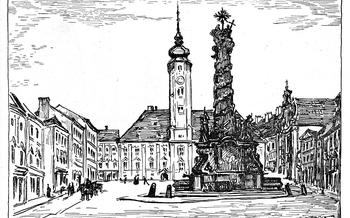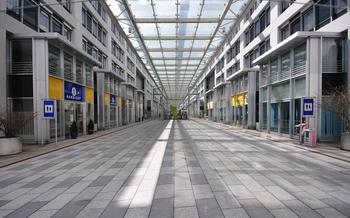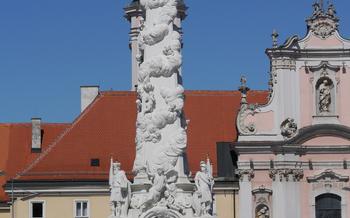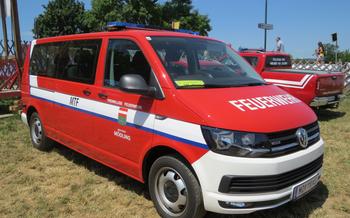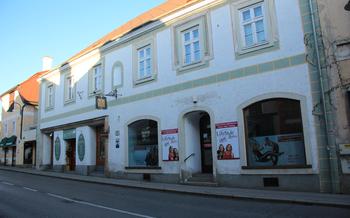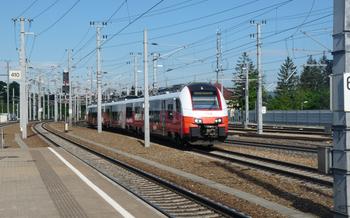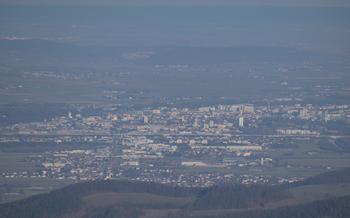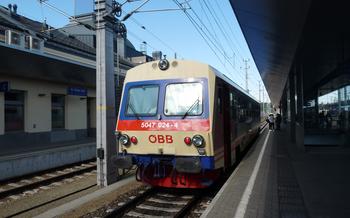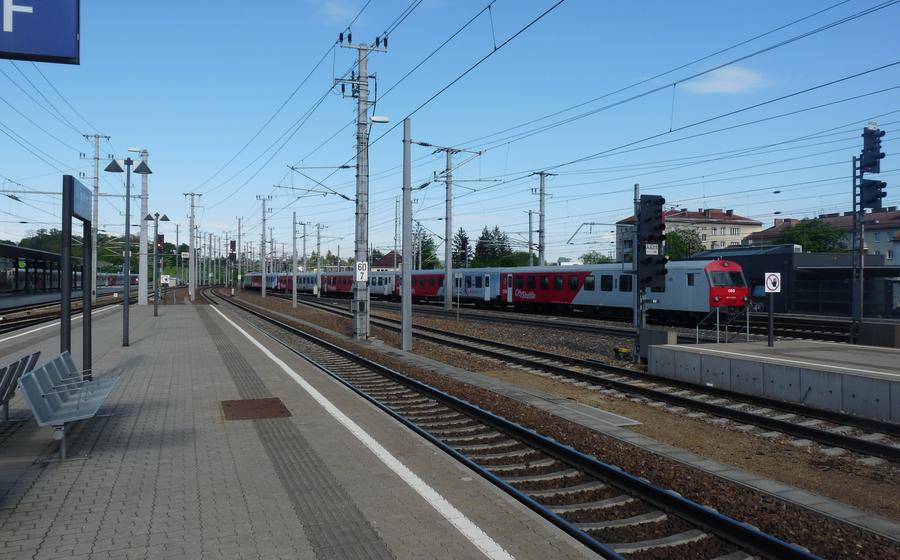
Government District (Landesregierungsviertel)
- Sankt Pölten: A City of Historical Charm and Modern Architecture
- Government District: A Symbol of Modernity and Efficiency
- Exploring the Government District: A Journey Through Architectural Masterpieces
- Guided Tours: Unveiling the Secrets of Government
- The Landtag Building: Where Democracy Resides
- The State Government Building: A Hub of Administrative Power
- The Cultural Quarter: Art, History, and Performance
- The State Library: A Treasure Trove of Knowledge
- The State Archives: Preserving the Past for Future Generations
- The Park of Remembrance: A Place for Reflection and Commemoration
- The VAZ St. Pölten: A Modern Venue for Events and Conferences
- Dining and Shopping: Culinary Delights and Retail Therapy
- Accessibility and Transportation: Getting There and Getting Around
- Events and Festivals: A Vibrant Calendar of Celebrations
- Insider Tip: Hidden Gems and Local Favorites
Sankt Pölten: A City of Historical Charm and Modern Architecture
Sankt Pölten, the capital city of Lower Austria, is a captivating blend of historical charm and modern architectural wonders. With a history dating back to the Roman era, the city proudly showcases its rich heritage through numerous historical landmarks, including the 13th-century Gothic cathedral and the Renaissance town hall. In contrast, the Government District, a striking complex of contemporary buildings, represents Sankt Pölten's embrace of modernity.
Sankt Pölten's geographical location, situated at the confluence of the Traisen and Pielach rivers, has played a significant role in its development. The city's strategic position along trade routes contributed to its early prosperity and cultural exchange. Today, Sankt Pölten serves as a vibrant economic hub, home to various industries, including manufacturing, technology, and tourism.
Culturally, Sankt Pölten boasts a diverse array of attractions, including museums, theaters, and art galleries. The city's cultural significance is further enhanced by its numerous festivals and events, showcasing music, art, and local traditions. Sankt Pölten's unique blend of historical charm and modern architecture, coupled with its rich cultural offerings, makes it a must-visit destination for travelers seeking an authentic Austrian experience.
Government District: A Symbol of Modernity and Efficiency
The Government District in Sankt Pölten stands as a testament to Austria's commitment to modern governance and architectural innovation. Constructed between 1992 and 2007, the district houses the offices of the state government of Lower Austria, along with various cultural and educational institutions. Its striking design, characterized by clean lines, geometric shapes, and glass facades, reflects the forward-thinking spirit of the region.
The decision to establish the Government District in Sankt Pölten was driven by a desire to decentralize political power and promote regional development. The district's location on the western edge of Vienna, the country's capital, symbolizes this shift towards a more balanced distribution of authority. The proximity to the capital ensures efficient communication and collaboration while allowing the state government to maintain its own distinct identity.
The Government District serves as the nerve center of political activity in Lower Austria. It houses the offices of the state governor, the Landtag (regional parliament), and various administrative departments. The district's modern infrastructure and facilities provide a conducive environment for decision-making and policy implementation. The presence of the government in Sankt Pölten has had a significant impact on the city's economy and cultural landscape, transforming it into a vibrant and thriving regional capital.
In addition to its political significance, the Government District is also a major tourist attraction. Its unique architecture, public spaces, and cultural offerings draw visitors from across the country and beyond. Whether you're a history buff, an architecture enthusiast, or simply looking for a glimpse into the inner workings of government, the Government District has something to offer everyone.
Exploring the Government District: A Journey Through Architectural Masterpieces
The Government District in Sankt Pölten is not only a hub of political power but also a showcase of remarkable architecture. As you wander through the complex, you'll encounter a variety of buildings, each with its unique design and function.
At the heart of the district lies the Landtag Building, the seat of the provincial parliament. Its striking exterior, featuring a glass facade and a curved roof, symbolizes openness and transparency in decision-making. Inside, the plenary hall, where debates and votes take place, is a testament to the democratic process.
Another architectural highlight is the State Government Building, which houses the offices of the provincial governor and other administrative departments. Its imposing facade, adorned with columns and intricate carvings, exudes an aura of authority and power.
The Cultural Quarter, located within the Government District, adds a touch of creativity and vibrancy to the complex. It comprises several museums, theaters, and exhibition spaces, showcasing a diverse range of art, history, and culture. The State Library, with its impressive collection of books and manuscripts, is a treasure trove for bibliophiles.
Public spaces and green areas are carefully integrated into the Government District, providing a sense of balance and harmony. The Park of Remembrance, with its serene atmosphere and poignant memorials, invites visitors to reflect on the past and the sacrifices made for freedom and democracy.
Exploring the Government District is a journey through architectural masterpieces, where each building tells a story about the history, culture, and politics of Sankt Pölten and Austria.
Guided Tours: Unveiling the Secrets of Government
The Government District offers guided tours as an exceptional opportunity to delve deeper into its history, architecture, and significance. These tours are available to both individuals and groups, providing a fascinating glimpse into the inner workings of Austrian politics and governance.
There are two main types of guided tours available: a general overview tour and a thematic tour. The general overview tour provides a comprehensive introduction to the Government District, covering its history, architectural highlights, and major institutions. The thematic tour, on the other hand, focuses on a specific aspect of the district, such as its role in Austrian politics, its cultural significance, or its sustainable design features.
During the tours, knowledgeable guides share captivating stories and anecdotes about the buildings, the people who have shaped the district, and the events that have taken place within its walls. Visitors are granted access to areas that are normally closed to the public, such as the plenary hall of the Landtag or the historic chambers of the State Government Building.
To book a guided tour, visitors can contact the Government District's visitor center or make a reservation online. It is advisable to book in advance, especially for larger groups. Tours are typically conducted in German, but English-language tours can be arranged upon request.
Whether you are a history buff, an architecture enthusiast, or simply curious about the inner workings of government, the guided tours of the Government District offer an unforgettable and enriching experience.
The Landtag Building: Where Democracy Resides
The Landtag Building, an architectural masterpiece nestled within the Government District, serves as the seat of the Landtag, the provincial parliament of Lower Austria. Its striking design, characterized by clean lines, geometric forms, and a glass façade, reflects the transparency and openness of the democratic process. The building's façade is adorned with intricate metalwork, symbolizing the interconnectedness of the various regions within Lower Austria.
Inside, the Landtag Building boasts a spacious plenary hall, where debates, discussions, and decisions take place. The hall features comfortable seating for members of the Landtag, as well as a public gallery, allowing visitors to witness the democratic process firsthand. The building also houses committee rooms, offices for Landtag members, and various administrative departments.
Visitors to the Landtag Building can take guided tours to learn about the history, architecture, and functions of this important institution. Tours provide insights into the legislative process, the role of the Landtag in Austrian politics, and the significance of the building's design. Reservations for tours can be made in advance through the Landtag's website.
The Landtag Building is not only a symbol of democracy but also a venue for special events, conferences, and exhibitions. Its modern facilities and versatile spaces make it an ideal choice for hosting gatherings of all kinds. Whether attending a plenary session, participating in a guided tour, or simply admiring its architectural beauty, the Landtag Building offers a unique glimpse into the heart of Austrian democracy.
The State Government Building: A Hub of Administrative Power
The State Government Building, a prominent landmark within the Government District, embodies the administrative authority of the state government of Lower Austria. Constructed in the late 1990s, this modern and functional building reflects the forward-looking approach of the regional government.
Architecturally, the State Government Building showcases a sleek and contemporary design, characterized by clean lines, glass facades, and open spaces. Its unique shape, resembling a curved sail, symbolizes the dynamism and progression of the region.
The building serves as the primary office space for the state government, housing various departments and offices responsible for a wide range of administrative functions. These departments oversee areas such as finance, education, health, and environmental protection, among others.
The State Government Building is not only a center for administrative work but also a venue for official meetings, conferences, and public events. Its spacious meeting rooms and auditoriums provide a platform for discussions, decision-making, and public engagement.
Throughout its history, the State Government Building has witnessed numerous significant events and decisions that have shaped the development of Lower Austria. It stands as a symbol of modern governance and the commitment to serving the people of the region.
The building is open to the public during designated hours, allowing visitors to explore its architectural features and learn about the important role it plays in the functioning of the state government. Guided tours are also available, providing insights into the history, operations, and decision-making processes that take place within its walls.
The Cultural Quarter: Art, History, and Performance
The Government District in Sankt Pölten is not just a hub of political power but also a vibrant cultural center. The cultural quarter within the district boasts an array of museums, theaters, and exhibition spaces that showcase the city's rich history, artistic talent, and vibrant cultural scene.
One of the highlights is the Museum Niederösterreich, which houses a vast collection of artifacts and exhibitions showcasing the cultural and natural heritage of Lower Austria. Visitors can explore the state's history from prehistoric times to the present day, marvel at stunning works of art, and learn about the region's unique traditions and customs.
The Festspielhaus St. Pölten, a modern theater and concert hall, is another cultural landmark within the district. It hosts a diverse program of performances, including theater productions, concerts, operas, and dance shows. The state-of-the-art facilities and exceptional acoustics make it a popular venue for both local and international artists.
The Cinemaplexx St. Pölten offers a cinematic experience like no other. With its multiple screens, cutting-edge technology, and comfortable seating, it's the perfect place to catch the latest blockbusters or enjoy a classic film.
The integration of art and culture into the Government District creates a harmonious blend of modernity and tradition. Sculptures, murals, and other public artworks adorn the streets and plazas, adding a touch of creativity and inspiration to the urban landscape.
The cultural quarter is a must-visit for anyone interested in delving deeper into the artistic and cultural side of Sankt Pölten. It offers a diverse range of experiences that cater to every taste, from history buffs to art enthusiasts and theater lovers.
The State Library: A Treasure Trove of Knowledge
The State Library of Lower Austria, nestled within the Government District of Sankt Pölten, stands as a testament to the region's rich cultural heritage and intellectual pursuits. Its history dates back to the early 19th century, when it was established as the provincial library of Lower Austria. Over the years, it has grown into a vast repository of knowledge, housing a diverse collection of over 300,000 books, manuscripts, and periodicals.
The State Library occupies a prominent position within the Government District, housed in a stately building that exudes an aura of grandeur and scholarly pursuits. Its architectural design blends classical and modern elements, creating a space that is both functional and aesthetically pleasing. The reading rooms, with their high ceilings, ornate chandeliers, and rows of wooden bookshelves, provide a serene and inspiring atmosphere for study and research.
The library's collection encompasses a wide range of subjects, including history, literature, art, music, and science. It boasts a particularly rich collection of works related to the history and culture of Lower Austria, making it an invaluable resource for scholars and researchers. Among its treasures are rare manuscripts, first editions, and historical documents that provide a glimpse into the region's past.
In addition to its extensive collection, the State Library also offers a variety of services to its patrons. These include interlibrary loans, document delivery, and access to online databases and resources. The library also hosts regular events, workshops, and exhibitions that promote literacy, scholarship, and a love of learning.
The State Archives: Preserving the Past for Future Generations
The State Archives of Lower Austria, located within the Government District, plays a crucial role in preserving and documenting the region's rich history. Its vast collection of historical documents, dating back to the Middle Ages, provides invaluable insights into the political, social, and cultural developments of Lower Austria.
The archives house a diverse range of materials, including official documents, manuscripts, maps, photographs, and audio-visual recordings. These collections offer a comprehensive record of the region's past, from medieval charters and land registers to modern administrative documents.
Researchers and scholars from around the world visit the State Archives to access its unique holdings. The archives provide specialized research facilities, including reading rooms and consultation services, to facilitate the study of historical documents.
The State Archives also organizes exhibitions, workshops, and educational programs to raise awareness about the importance of preserving cultural heritage. These events provide opportunities for the public to engage with historical documents and learn about the fascinating stories they hold.
By safeguarding and making accessible these valuable records, the State Archives ensures that the past remains a living part of the present, contributing to a deeper understanding of Lower Austria's identity and heritage.
The Park of Remembrance: A Place for Reflection and Commemoration
Amidst the bustling activity of the Government District lies a serene oasis of remembrance and reflection known as the Park of Remembrance. This poignant greenspace pays tribute to the victims of war and tyranny, serving as a reminder of the horrors of the past and the importance of fostering peace and understanding.
Established in 1988, the Park of Remembrance features a series of monuments and memorials that honor those who have suffered and perished as a result of war and oppression. The centerpiece of the park is the Memorial to the Victims of War, a towering sculpture that depicts the suffering and resilience of the human spirit. Other monuments commemorate specific conflicts, such as the World Wars and the Holocaust, as well as victims of political persecution and violence.
The park's tranquil atmosphere and serene surroundings provide a contemplative space for visitors to reflect on the past and pay their respects to those who have been lost. Educational programs and events are also held in the park, fostering dialogue and understanding about the causes and consequences of war and tyranny.
The Park of Remembrance serves as a powerful reminder of the importance of learning from the past and working towards a future free from conflict and oppression. It is a place where visitors can come to remember, reflect, and renew their commitment to peace and reconciliation.
The VAZ St. Pölten: A Modern Venue for Events and Conferences
The VAZ St. Pölten, an abbreviation for Veranstaltungszentrum St. Pölten, is a state-of-the-art venue located within the Government District, offering a versatile space for a wide range of events and conferences. Its modern architecture and cutting-edge facilities make it a popular choice for both local and international organizers seeking a professional and sophisticated setting for their events.
With a capacity to accommodate up to 1,000 guests, the VAZ St. Pölten features a large auditorium equipped with advanced audio-visual technology, ensuring seamless presentations and conferences. The venue's modular design allows for flexible configurations, adapting to different event formats, from intimate seminars to large-scale conferences and exhibitions.
The VAZ St. Pölten has played host to a diverse array of events, including political summits, international conferences, corporate functions, and cultural performances. Notable events held at the venue have included the Austrian Presidency of the European Union in 2006, the World Games of Mountain Biking in 2012, and the European Forum Alpbach in 20
For attendees, the VAZ St. Pölten provides a range of amenities to ensure a comfortable and productive experience. These include spacious foyers for networking and socializing, a business center with secretarial services, and a catering area offering a variety of refreshments and meals.
The VAZ St. Pölten is conveniently accessible by public transportation, with direct bus and train connections to the Government District. Ample parking is also available for those arriving by car.
Dining and Shopping: Culinary Delights and Retail Therapy
The Government District of St. Pölten offers a diverse range of dining options to satisfy every palate. From casual cafes and bistros to elegant restaurants, there's something for everyone. Local cuisine takes center stage, showcasing traditional Austrian dishes prepared with fresh, seasonal ingredients. Don't miss the chance to try local specialties like Wiener Schnitzel, Tafelspitz, or Käsespätzle. International flavors are also well-represented, with restaurants serving Italian, Asian, and Mediterranean cuisine.
For those seeking retail therapy, the Government District offers a variety of shopping opportunities. Souvenir shops stock a range of items, from traditional handicrafts to modern souvenirs, allowing visitors to take a piece of St. Pölten home with them. Fashion boutiques offer a selection of stylish clothing and accessories, while bookstores and art galleries provide a haven for culture enthusiasts. Whether you're looking for a unique gift, a new outfit, or simply a good book, you're sure to find it within the Government District.
The district seamlessly blends work and leisure, offering opportunities to unwind and recharge after a busy day of meetings or sightseeing. Whether you're grabbing a quick coffee, savoring a leisurely lunch, or indulging in a gourmet dinner, the Government District has something to suit every taste and occasion.
Accessibility and Transportation: Getting There and Getting Around
The Government District is conveniently situated and offers various transportation options, ensuring visitors and employees can access the area seamlessly. Public transportation is the preferred mode of transport, with comprehensive bus and train networks connecting the district to various parts of the city and beyond. The St. Pölten Hauptbahnhof (main train station) is a short walk away, providing regional and national rail connections.
For those traveling by car, ample parking is available within the district. Designated parking areas and multi-story car parks cater to the needs of visitors and employees. Parking fees apply, and visitors are advised to check the signage and rates displayed.
The Government District is designed to be accessible to individuals with disabilities, ensuring they can navigate the area with ease. Ramps, elevators, and accessible restrooms are available throughout the complex, allowing everyone to enjoy the district's attractions and amenities.
Exploring the Government District on foot is an excellent way to appreciate its architectural grandeur and green spaces. The district's layout is pedestrian-friendly, with wide sidewalks and designated pedestrian zones. Bicycles are also a popular mode of transportation in St. Pölten, and bike paths and racks are provided within the district for cyclists' convenience.
Events and Festivals: A Vibrant Calendar of Celebrations
The Government District of Sankt Pölten is not only a hub of political activity but also a vibrant center for cultural and social events. Throughout the year, the district hosts a diverse calendar of events and festivals that attract both locals and visitors alike. These events showcase the rich cultural heritage of the region and offer a chance to experience Austrian traditions and festivities firsthand.
One of the highlights of the year is the Niederösterreichische Landesausstellung, a major cultural exhibition that takes place every few years. The exhibition showcases the history, culture, and traditions of Lower Austria, and features a variety of exhibits, performances, and workshops. Another popular event is the St. Pölten Festival, a month-long celebration of music, theater, and dance that attracts thousands of visitors each year.
In addition to these major events, the Government District also hosts a variety of smaller events and festivals throughout the year. These events include concerts, art exhibitions, film screenings, and farmers' markets. There is always something happening in the Government District, so be sure to check the calendar before your visit to see what's on.
If you're looking for a truly unique experience, be sure to attend one of the many traditional Austrian festivals held in the Government District. These festivals celebrate the region's rich cultural heritage and feature traditional music, dancing, food, and drink. Some of the most popular festivals include the Oktoberfest, the Weihnachtsmarkt, and the Fasching.
No matter what time of year you visit, you're sure to find something to enjoy in the Government District of Sankt Pölten. With its vibrant calendar of events and festivals, there's always something happening to keep you entertained.
Insider Tip: Hidden Gems and Local Favorites
Beyond the iconic landmarks, the Government District holds hidden gems waiting to be discovered. For breathtaking views, venture to the rooftop terrace of the Landtag Building, offering panoramic vistas of the city and the surrounding countryside. Capture Instagram-worthy shots at the colorful murals adorning the walls of the State Archives, a testament to the city's vibrant street art scene.
For a taste of local life, head to the weekly farmers' market held in the park adjacent to the Government District, where you can savor fresh produce, artisanal cheeses, and traditional Austrian pastries. Immerse yourself in the city's rich history at the St. Pölten Museum, showcasing fascinating exhibits on the region's past.
To experience the vibrant nightlife, venture beyond the Government District to the Old Town, where charming bars and lively music venues await. For a unique souvenir, visit the Werkstätte Handcrafted Shop, featuring locally made pottery, jewelry, and other handcrafted treasures. Embrace the local spirit and enjoy the many hidden gems that make St. Pölten a truly special destination.
